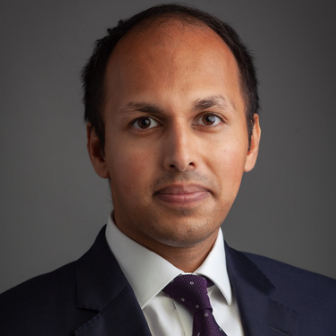Christopher Lees
Senior Fund Manager
Host:
The crisis in Europe following the invasion of Ukraine by Russia has hit financial markets, though it's fair to say the reaction from investors has been somewhat muted with little panic buying and selling at this stage. In times like these, how should investors think about their portfolios? Do they hunker down? Do they buy the dips? Do they sell? Or is it more or less business as usual? To help find some answers, I'm talking to Chris Lees, manager of the JOHCM Global Select Fund. Thanks for joining us, Chris. Now I want to get onto kind of more about interest rates and the inflection point in the economies at the moment. But before we start, how do you think about a crisis like what's happening in Ukraine at the moment?
Chris Lees:
Well, obviously it's a humanitarian disaster. And the situation's moving so fast, I don't think I have much to add other than on average, markets tend to sell the bad news rumor and weirdly, markets often buy the bad news event. However, now the risk is escalation and we'll just have to wait and see.
Host:
Okay, so don't panic.
Chris Lees:
Correct. It's probably too early to sell, but it's also probably too early to buy the dip.
Host:
If you put that aside, the theme running through financial markets obviously is interest rate inflection point, because I know that you actually have been in the market for decades. You may have seen this before. How do you think about it? How should an investor be thinking about inflection points in interest rates? Because many investors, sort of younger ones, haven't come across it before.
Chris Lees:
Yeah, that's absolutely right. And one should have a quick look at history and see what happened in the past and then realize that every cycle is slightly different and think about what will be slightly different this time. And what Nudgem and I think will be slightly different this time is the Fed is starting to raise interest rates as the global economy was already slowing. Ouch, that's going to be painful. That's going to be slightly different. In the past the Fed was raising interest rates as the global economy was still accelerating, but because of COVID, it got delayed. So this time is slightly different. I'll just repeat that. This time is slightly different in that the Fed hasn't even started raising rates. It's talking about them. And actually, if you look at GDP growth rates, they're beginning to slow and inflation rates are probably peaking. So it will be very volatile. It'll be a very volatile time for financial assets. It always is as you look in history when interest rates go up. And it'll be slightly different from previous playbooks because the timing and the sequencing is slightly different.
Host:
Can you give us an insight into how you think that will play out? That doesn't sound real good to me from my basic economics.
Chris Lees:
The potential is for what we call scenario three, a big bear market. That's the potential. It's a low probability potential at the moment, but every day the probabilities of that are drifting up. And of course, what's going on in Ukraine, the disaster in Ukraine, probably increases that risk.
Chris Lees:
The bullish potential is that actually this is a normal mid cycle correction. And it's too early to tell folks at the moment whether this is a normal mid cycle correction. You'll see lots of statistics about the market still goes up when the Fed raises rates. So that's what we're balancing. We're looking at the evidence and I would say that what's going on in the Ukraine obviously tilts the properties of an energy crisis, which we have to start thinking of oil and natural gas not as long term stranded assets, which is how we previously used to think of them. But we have to start thinking of oil and natural gas actually as short to medium term strategic assets, which are being weaponized in geopolitics.
Chris Lees:
So there are some very significant differences from a normal cycle, as I'm trying to emphasize for you. And the real message is it's too early to tell which way it's going to go. We'll watch the data and as we get more evidence where if it's a mid cycle correction, we'll be buying the dip. If we get more evidence that actually this is a late cycle, genuine bear market, we'll be selling any rallies.
Host:
So what are the key points that you are looking for? The data sets that you're looking at to make that call?
Chris Lees:
Well, we watch GDP numbers. We watch inflation numbers obviously. We watch credit spreads. I would say to the listeners, credit markets are very, very important to look at to give you that answer. They tend to sniff out any problems, any genuine problems. So it's very important for us our credit spreads, which up until now have been behaving very well. We watch for market signals. There's a dashboard of market signals that begin to tell you that you're crossing a tipping point or not.
Host:
Now, if we take a step back, you have a great belief in decades of trends. And you've spoken to me previously and been in the media previously about where technology sits, as well as other asset classes. If you look forward to the next five, 10 years and beyond, what are the sorts of asset classes that you think long term, forget Ukraine, forget even inflection points and interest rates, other things investors should be thinking about?
Chris Lees:
Yeah, that's exactly the right thing to do. And to recognize that in all the short term noise, there's always long term opportunities. To do that, you need to process, an objective process. And ours is we look at the fundamentals first. So that's revenue growth, earnings growth, margins, profitability. And then we look at valuation second. Is this thing cheap relative to history or expensive relative to history? And then maybe most importantly, we look at the trend of both of those. We look at the trend of the fundamentals, we at the trend of the valuation, and we look at the trend of the share price. Are things actually getting better or worse and is the share price or the asset class actually trending up or down? And when you put everything through that lens, you begin to get the answers.
Chris Lees:
So for example, healthcare begins to look very attractive on a 10 year view. Healthcare's got great fundamentals. It was healthcare and biotech that got us out of the COVID mess, for example. And yet, your listeners might be surprised to hear, US biotech is trading at an all-time low relative valuation. That's so important. I'll repeat it again. Biotech's got great fundamentals, and yet it's trading at an all-time low relative valuation. So that's really very interesting and it's got nothing to do with Ukraine. It's got nothing to do with US interest rates. It's probably a really good, very long term opportunity for us. But at the moment, it's got a very bad trend. And the problem with negative trends is you could lose money. Even on good assets you can lose money if the trend is down. So our process says, wait until the price trend turns before you actually buy.
Chris Lees:
So there's an example of what we're looking for. We've identified what we'd call two green lights on healthcare and specifically US biotech. Green light fundamentals, green light valuation, but we still have a red light on trend. Once that red light on trend turns to orange or green, then we'll start to be buying. And we think that could well be a fabulous decade long new trend.
Host:
Thanks for joining us today, Chris. If you want to know more about Chris, J O Hambro or the JOHCM Global Select Fund, then please visit johcm.com.
This podcast is for professional investors only. The information contained within this podcast including any expression of opinion is for information purposes only and is given on the understanding that it is not a recommendation. Views as of date of recording, 10 March 2022, and are subject to change. Past performance is no guarantee of future performance. The value of investments and the income from them may go down as well as up and you may not get back your original investment.
By clicking Proceed I confirm I have read the important information and agree to the terms of use.
This website uses cookies to remember your preferences and help us improve the site. By proceeding, you agree to cookies being placed on your computer. Read our privacy and cookie notices.
For a better experience, we recommend viewing this website in landscape orientation.

Head of Equity Impact Solutions
14 years' industry experience, joined Regnan in June 2020.
Tim Crockford leads the Regnan Equity Impact Solutions team. He previously managed the Hermes Impact Opportunities Equity Fund from its launch in December 2017, having co-founded the Hermes Impact team in 2016. Tim joined Hermes Investment Management in 2009 as a research analyst for the European Equities team and became lead portfolio manager of the ESG-integrated Hermes Europe ex-UK Equity Fund in 2015, which he also managed until he left Hermes.

CFA, Fund Manager
13 years’ industry experience, joined Regnan in May 2020.
Mohsin is a fund manager dedicated to the strategy. He was previously a senior analyst on the Hermes Impact Opportunities Equity Fund, having joined Hermes in 2017. Prior to Hermes, Mohsin was an investment manager in Global Equities at Pictet Asset Management. At Pictet his experience included working on thematic equity funds including Water, Clean Energy and Agriculture.

CFA, Analyst
10 years’ industry experience, joined Regnan in May 2020.
Maxime is an investment analyst dedicated to the strategy. He has a decade of experience in sustainable investment. Previously, as an investment analyst at Hermes from 2016, he participated in the design, launch and management of the Hermes Impact Opportunities Equity Fund. Prior to this he led the integration of ESG and stewardship across investment strategies.

CFA, Analyst
6 years’ industry experience, joined Regnan in April 2020.
Maxine is an investment analyst dedicated to the strategy. She was previously an analyst on the Hermes Impact Opportunities Equity Fund. Maxime transferred to the Hermes Impact team in 2016, having initially joined the Hermes EOS team in 2014. She headed up the chemicals sector team, while also focusing on the financial services, industrials and technology sectors.
